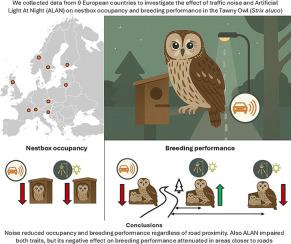Sensory pollutants have negative but different effects on nestbox occupancy and breeding performance of a nocturnal raptor across Europe
IF 4.4
1区 环境科学与生态学
Q1 BIODIVERSITY CONSERVATION
引用次数: 0
Abstract
Anthropogenic noise and artificial light at night (ALAN) are expanding globally, acting as pervasive sensory pollutants that can disrupt wildlife behaviour and reproduction. While most research has focused on diurnal species, the effects of these pollutants on the ecological response of nocturnal predators remain poorly understood. Using data from nine European countries, we investigated the effects of traffic noise, ALAN, and road proximity on nestbox occupancy and reproduction in the Tawny Owl (Strix aluco), a nocturnal raptor widespread across Europe. Traffic noise consistently reduced both nestbox occupancy and reproductive success regardless of road proximity. ALAN also impaired occupancy and reproduction, but its negative effect on reproduction changed based on the proximity to roads. Interestingly, the negative effect of ALAN was stronger in sites further from roads, but it attenuated in their proximity, where owls' hatching success and brood size moderately improved. This finding suggests that near roads, where prey abundance and availability are also generally high, owls may either find the prey regardless of ALAN or they may exploit it to facilitate hunting and brood provisioning. However, vicinity to roads might enhance mortality by vehicle collisions, which represents one of the greatest threats for the conservation of owls. Our findings highlight that anthropogenic noise and the co-occurrence between ALAN and roads can affect settlement decisions and breeding performance in nocturnal raptors, with potential consequences across the food chain. Mitigating anthropogenic noise and promoting nighttime-lighting systems that minimize owls' presence close to roads will represent valuable actions to improve their conservation.

感官污染物对欧洲夜间猛禽的巢箱占用和繁殖性能有负面但不同的影响
人为噪音和夜间人造光(ALAN)正在全球范围内扩张,它们是无处不在的感官污染物,可以扰乱野生动物的行为和繁殖。虽然大多数研究都集中在昼行性物种上,但这些污染物对夜间捕食者生态反应的影响仍然知之甚少。利用来自9个欧洲国家的数据,我们调查了交通噪音、ALAN和道路邻近程度对遍布欧洲的夜行猛禽褐鸮(Strix aluco)巢箱占用和繁殖的影响。无论是否靠近道路,交通噪音都会降低巢箱的占用率和繁殖成功率。ALAN也会影响占用和繁殖,但其对繁殖的负面影响会随着道路的远近而变化。有趣的是,ALAN的负面影响在远离道路的地方更强,但在靠近道路的地方,它的影响减弱,猫头鹰的孵化成功率和孵化规模适度提高。这一发现表明,在道路附近,猎物的数量和可用性通常也很高,猫头鹰可能会找到猎物,而不考虑ALAN,或者它们可能会利用它来促进狩猎和产卵。然而,靠近道路可能会增加车辆碰撞造成的死亡率,这是猫头鹰保护面临的最大威胁之一。我们的研究结果强调,人为噪音以及ALAN和道路之间的共同存在会影响夜间猛禽的定居决策和繁殖表现,并对整个食物链产生潜在影响。减少人为噪音和推广夜间照明系统,减少猫头鹰在道路附近的存在,将是改善猫头鹰保护的有价值的行动。
本文章由计算机程序翻译,如有差异,请以英文原文为准。
求助全文
约1分钟内获得全文
求助全文
来源期刊

Biological Conservation
环境科学-环境科学
CiteScore
10.20
自引率
3.40%
发文量
295
审稿时长
61 days
期刊介绍:
Biological Conservation is an international leading journal in the discipline of conservation biology. The journal publishes articles spanning a diverse range of fields that contribute to the biological, sociological, and economic dimensions of conservation and natural resource management. The primary aim of Biological Conservation is the publication of high-quality papers that advance the science and practice of conservation, or which demonstrate the application of conservation principles for natural resource management and policy. Therefore it will be of interest to a broad international readership.
 求助内容:
求助内容: 应助结果提醒方式:
应助结果提醒方式:


